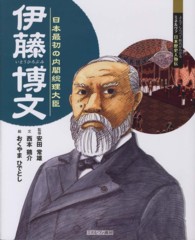- ホーム
- > 洋書
- > 英文書
- > Science / Mathematics
Full Description
This book is written for those who would like to advance their knowledge beyond an introductory level of biomaterials or materials science and engineering. This requires one to understand more fully the science of materials, which is, of course, the foundation of biomaterials. The subject matter of this book may be divided into three parts: (1) fundamental structure-property relationships of man-made materials (Chapters 2-5) and natural biological materials, including biocompatibility (Chapters 6 and 7); (2) metallic, ceramic, and polymeric implant materials (Chapters 8-10); and (3) actual prostheses (Chapters 11 and 12). This manuscript was initially organized at Clemson University as classnotes for an introductory graduate course on biomaterials. Since then it has been revised and corrected many times based on experience with graduate students at Clemson and at Tulane University, where I taught for two years, 1981-1983, before joining the University of Iowa. I would like to thank the many people who helped me to finish this book; my son Y oon Ho, who typed all of the manuscript into the Apple Pie word processor; my former graduate students, M. Ackley Loony, W. Barb, D. N. Bingham, D. R. Clarke, J. P. Davies, M. F. DeMane, B. J. Kelly, K. W. Markgraf, N. N. Salman, W. J. Whatley, and S. o. Young; and my colleagues, Drs. W. Cooke, D. D. Moyle (Clemson G. H. Kenner (University of Utah), F. University), W. C. Van Buskirk (Tulane University), and Y.
Contents
1 Introduction.- 1.1. Definition of Biomaterials.- 1.2. Brief Historical Background.- Problems.- References.- 2 Characterization of Materials.- 2.1. Mechanical Properties.- 2.2. Viscoelasticity.- 2.3. Viscoelasticity in Dynamics Tests.- 2.4. Elasticity of Non-Hookean Materials.- Problems.- References.- 3 Structure of Solids.- 3.1. Atomic and Molecular Bonding.- 3.2. Crystal Structure of Solids.- 3.3. Crystal Imperfections.- 3.4. Noncrystalline Solids.- Problems.- References.- 4 Thermodynamics of Structural Changes.- 4.1. Thermodynamic Relationships.- 4.2. Rates of Reactions.- 4.3. Phase Changes.- 4.4. Diffusion.- 4.5. Surface Properties.- Problems.- References.- 5 Strength and Strengthening Mechanisms.- 5.1. Strengths of Perfect and Real Materials.- 5.2. Strength and Strengthening of Metals and Simple Ionic Solids.- 5.3. Strength and Strengthening of Ceramics and Glasses.- 5.4. Strength and Strengthening of Polymers.- 5.5. Properties of Composites.- Problems.- References.- 6 Structure-Property Relationships Of Biological Materials.- 6.1. Structure of Proteins and Polysaccharides.- 6.2. Structure-Property Relationship of Tissues.- 6.3. Elastic Tissues.- 6.4. Constitutive Equations Describing Mechanical Properties of Soft Tissues.- Problems.- References.- 7 Tissue Response to Implants (Biocompatibility).- 7.1. Wound-Healing Process.- 7.2. Body Response to Implants.- 7.3. Blood Compatibility.- Problems.- References.- 8 Metallic Implant Materials.- 8.1. Stainless Steels.- 8.2. Co-Based Alloys.- 8.3. Ti and Ti-Based Alloys.- 8.4. Other Metals.- 8.5. Deterioration of Metallic Implant Materials.- Problems.- References.- 9 Ceramic Implant Materials.- 9.1. Aluminum Oxides.- 9.2. Hydroxyapatite.- 9.3. Glass-Ceramics.- 9.4. Other Ceramic Implants.- 9.5. Carbons.- Problems.- References.- 10 Polymeric Implant Materials.- 10.1. Polymerization.- 10.2. Solid State of Polymers.- 10.3. Effect of Structural Modifications on Properties.- 10.4. Polyolefins.- 10.5. Polyamides (Nylons).- 10.6. Acrylic Polymers.- 10.7. Fluorocarbon Polymers.- 10.8. Rubbers.- 10.9. High-Strength Thermoplastics.- 10.10. Deterioration of Polymers.- Problems.- References.- 11 Soft Tissue Replacement Implants.- 11.1. Sutures, Surgical Tapes, and Adhesives.- 11.2. Percutaneous and Skin Implants.- 11.3. Maxillofacial and Other Soft Tissue Augmentation.- 11.4. Blood Interfacing Implants.- Problems.- References.- 12 Hard Tissue Replacement Implants.- 12.1. Internal Fracture Fixation Devices.- 12.2. Joint Replacements.- 12.3. Dental Implants.- Problems.- References.- APPENDIX A: PHYSICAL CONSTANTS.- APPENDIX B: SI UNITS.- ANSWERS TO PROBLEMS.- NAME INDEX.
















